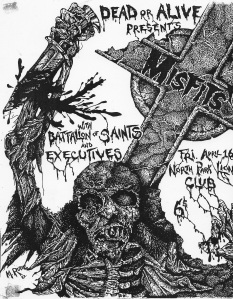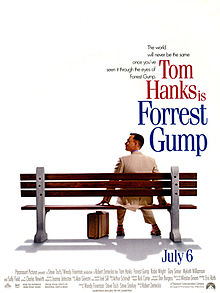Bayer Conference Center, Thursday, December 5, from 10:50 a.m. to 1:45 p.m.
Mary Rombadant (11:25)
The Power and the Passion of Alt-J
A wave of guitar reverberates in the ear and smooth, haunting voices emerge from the headphones. Alt-J is more than just another band crawling to the top with their unique sound, and their songs are much more than a party filled with good beats. The sophisticated song lyrics on their album An Awesome Wave are encrypted with a sea of subtext and extend past the usual boundaries of indie music by addressing gender, social class, power, domination, and oppression through allusions to literary works and films. Many of their songs relate to “pop culture as a wave that “washes over you and makes you feel good”[…] but also to the escapist quality of Hollywood cinema and television…” (Kooijman 22). Alt-J hits these social issues head-on while making a listener really understand the meaning behind their songs.
Nicholas Espinoza (11:55)
Zombie Takeover
Now more than ever, zombies are becoming the pinnacle of modern day pop culture in America. The media is feeding America’s newfound hunger with shows like The Walking Dead and movies like World War Z. The zombie fascination really steamrolled after George A. Romero’s Night of the Living Dead. The film horrified audiences across the nation so much that major controversy was brought up to question about the film’s intense plot. Roger Ebert says, “The kids in the audience were stunned. There was almost complete silence. The movie had stopped being delightfully scary about halfway through, and had become unexpectedly terrifying…” Zombies have become important to American Culture because they have revolutionized the modern monster, pushed the morality of mankind, and established an enormous following ever since their popular explosion in 1968.
Stefany Romo
Lady Gaga: Taking Over Pop Culture
Lady Gaga, formerly known as Stefani Germanotta, stampeded her way into pop culture in 2008 with her record-breaking debut album The Fame. Lady Gaga adds life to her songs with the mind-blowing performances that she puts together. The wardrobe she chooses to wear is far from normal; whether she is wearing a meat dress, go-go boots, or claws on her hands, she doesn’t care what the tabloids say about her abnormality. Lady Gaga reported to Oprah she “was and is a freak, a misfit, a lost soul to her fellow travelers,” anything, but not just an image. Lady Gaga is a unique artist to today’s world of pop culture because her character portrays the importance of non-judgmental values, her songs are a hybrid mix of music genres from the tune of pop to classical, and her fashion sense foreshadows a cutting edge style.
Erendida Hernandez (1:05)
Motifs in Frankenstein: The Consequence of Crossing Borders
In today’s time, the icon Frankenstein is considered to be nothing more than a way to frighten children, but back when the novel was first released by Mary Shelley, the themes and motifs located in the book were what caught the people’s attention. A lecturer in Romantic literature at the University of Sheffield named Angela Wright, comments, “[Mary Shelley] thought these people had crossed a line… [when working] on the re-animation of corpses.” The novel has been analytically scoured by scholars to understand what Mary Shelley was attempting to convey in her novel and how it judges the interactions between man against nature as well as man against man. The novel Frankenstein does this by covering the ideas of the consequences of crossing boundaries, whether scientifically or socially accepted and questions whether science is overstepping the line of “playing God” and when a juvenile is mature enough to take responsibility of creating new life.
.
Nakailla Kirkpatrick (12:10)
“Life is a box of chocolates”: Forrest Gump as Window into Ignored Margins
Forrest Gump is a 1994 American romantic comedy based on a 1986 book. Tom Hanks as Forrest Gump plays the role of a not so intelligent man that takes the audience through over 40 years of history, in which he is an important person in each event. Not only does he go through his life meeting all these famous people or achieving these wild dreams that others wish they could, Forrest pushes the boundaries of the normal life and strives for the best just because that is the way he was raised. Online, Leichtman states, “Forrest Gump included the difficulties of the lives of the socially marginal and the issue of whether life is simply a matter of fate, or whether it also essentially involves the choices made.” Winston Groom’s Forrest Gump is a iconic movie because it explores marginal lives, shows boundaries being challenged, and depicts morality of social class and race.
Tyler Woodward (11:00)
Texas Rodeos: The Traditions of Lone Star Celebrations
The Houston Rodeo is one of the most vital celebrations in the state of Texas because it embodies ethical, professional, and institutional values, it reflects cultural background in the rule area and shows the relationships between public and private. The Houston Rodeo is one of the many traditions still held in the state of Texas today. The huge rodeo celebrations are a very welcoming, fun, and rewarding place to be. From the mouth-watering food to the country concerts at night, Texas rodeos are very family-friendly place, because there is always something to do for everyone. Over the years, rodeos have changed so much. For example, Ralph Clark states, “The joining of competition with the gatherings would be the spark for what we now see as rodeos, originally two different aspects of western life joined to become a unique sport.” Most people think the Houston Rodeo is just the same thing every year, but it drastically changes in so many ways.
Jenni Miller (12:35)
The Beatles: The Politics of Pop
Slamming against Britain’s high tax bracket while delving into the world of psychedelics, The Beatles have an enormously impacting amount of diverse themes coming from their music. The Beatles album, Revolver, is culturally prominent because it demonstrates economic-based themes, challenged social order through their music, and also compared relationships between what was supposedly marginal and mainstream. In a Rolling Stone Internet article, an anonymous author states, “The album… made it thrillingly clear that what we now think of as ‘the Sixties’ was fully – and irreversibly – under way.” Songs like “Taxman,” “Tomorrow Never Knows,” and “Eleanor Rigby” represent worldly themes that are important in culture, such as Britain’s economic status at the time, marginality of some social classes, and the negative attitude toward the emergence of hard drugs.
Mason Brackeen
Drag Queens: A Historical Perspective of Controversy and Individuality
From birth, gender identity has always been the epitome of childhood surroundings from the different colors painted on walls and the toys played with to the shows people are sometimes putative to watch, much less enjoy. As such, people are often forced in our culture to conform to such a mundane frame of mind that society cannot think outside of the box—in other words, people cannot grasp or comprehend the concept of gender bending. However, the perception of Drag has for years broken this fabric and revolutionized the act of illusion. Drag Queens are a crucial subculture of the LGBT (Lesbian, Gay, Bisexual, and Transgender) community because they maintain a large importance for historical revolution in the gay community, represent a subculture that is fearless and vexing to today’s societal standards, and signify the continued movement for change in the world today. This emerging Drag culture consolidates the act of female impersonation and the artistic expression of the individual through stage performances, cosmetics, and various other outlets of creation. Referencing Drag Queens, blogger Joy Martin-Malone had so eloquently expresses, “Laughter is what helps us persevere; it lifts us out of our struggles… They are artists. They are able to conceptualize an idea and transform themselves… They are risk-takers.” This self-expression, usually a derivative of some sort of personal struggle, social issue, or ideology has sky-rocketed Drag culture into the spotlight of many films, social venues, and theatres over the years.
Niki Sutton
Wiccan: An Esoteric Culture
As early as 560 B.C., Wiccan culture has been perceived as evil and taboo. For hundreds of years, witches have been removed from society by means of exile and persecution, such as being burned alive, thrown into water with rocks tied to their feet, and other forms of torture. There is proof of this in Leviticus 20:27: “A man also or woman that hath a familiar spirit, or that is a wizard, shall surely be put to death: they shall stone them with stones: their blood shall be upon them” (KJV). Only because of their religious views and different ideas of “normal,” these people were put under this torture. Wiccanism is a significant culture because it subverts the stereotype of what people imagine when they hear “witches” or “witchcraft,” the disagreement of what is thought to be normal or abnormal, and it explores people’s ethical and religious values. This historical change – from persecution to being accepted – paved the way for modern society to be more tolerant of other religions and cultures.
Abbey Valencia (1:25)
Tattoos: A Vital Community
Tattoos over the last thousand years have evolved into a worldwide phenomenon. As so people ask themselves, “Why do people inflict pain upon themselves, especially when the process results in a permanent mark upon the body?” (Hewitt 1) There is no one solid answer as to why there are millions of reasons people mark their body with ink, and every one reason is essential. Tattoos are vital to people because they are a form of art expressing one’s cultural belief and can show personal memories and generally distinguish the characteristics of a person. Thus, they fall under the following subcultural groups: remembrance, identity, marginality, and the difference between the abnormal and normal.
David Fanestiel (1:10)
The Road
People try to prepare for when the world collapses but can someone ever be ready? Based on the novel of the same name The Road tells the story of a father and son fighting for survival in the post-apocalyptic world and what they will do to survive. The film is important because it shows how people are conflicted when trying to preserve social order in the face of savagery and explores how hope keeps people going in the future. The two main characters in the movie, The Man played by Viggo Mortensen and The Boy played by Kodi Smit-McPhee, must survive when the world has collapsed from an unknown event. According to Peters Travers, “The few who survive have utterly lost their moral compass,” but the boy still has his. The Man is determined to protect his son because he doesn’t want to leave his son without the skills to survive in this new world. His son is uncomfortable with the decisions that have to be made in this new bleak world: “The movie resists any tendency toward making the child cute, or the two of them heartwarming” (Ebert).
Alejandra Pena (1:15)
The Significance of Tattoos
Tattoos are significant because they are beautiful works of art that show certain events that people may have gone through in their life time, things that are valuable or precious to them, and also their cultural, religious, and personal beliefs. Tattooing has been around for many years. Although tattoos have a significance to some people, to others they may seem deceiving. In society today, people with tattoos are often seen as delinquents or people with no good intentions. I believe that people shall not judge another by what they have on their skin if they do not know the story behind it, for, “Tattoo can thus serve as both a transmission of and a challenge to differing forms of authority, in a double movement that encompasses the status of the designs; at once more than skin deep and marking the skin as a surface, the patterns remain both inside and outside the body” (Ellis 37).
Jessica Grubb (1:40)
Shock Rock: Obliterating Social Constraints
From its beginnings, rock and roll has functioned as a genre of music that taps into the raw, unadulterated emotions that, although exhibited by everyone, are, in many branches of society, perceived as inappropriate. No other subcategory of rock and roll displays these taboo emotions as effectively as shock rock. Shock rock is an essential part of rock culture because it embodies the traditional attitude of rock and roll, encourages people to take part in gender exploration, and questions the social boundaries of what the majority may see as acceptable or unacceptable. In his book, Rebels with Attitude: Subversive Rock Humorists, Lain Ellis states, “Youths emit the screams of joy and pain that most learn to contain or privatize. These outbursts – in rock and elsewhere – are often raw and uncivil because young people act out, oblivious (or resistant) to the decorum that comes with maturity and social manners. Rock humor harnesses such primal emotions, theatrically parading, loudly antagonizing, or just spitting on constraints. It exceeds the reasoned and rehearsed humor of even the most rebellious practitioners of other arts.” Whether an audience member is enthralled or appalled by the antics of shock rock, it undeniably forces its spectators to question their social and gender norms.
Grace Patiño (1:00)
Alice as Symbol of Boundary Breaking
The Alice series is an important series because it pushes the boundaries of juvenile fiction, it changes minds on what some people people perceive to be inappropriate or appreciate content in a book, and it differed from the common predictable ending books. Naylor talks about issues that some parents might not be comfortable telling their kids about but some believe that she should not do this in a series meant for underage kids. Phyllis Reynolds Naylor begun the Alice series in 1985. Later, it started developing in the 1990s with ideas of intimacy from the 70s, with such people that wanted to stay way from intimacy in the 80’s, and how they joined together in the 90s (Jones 90-91). Even now this makes some people excited and others scared, which in all should mean it is an important and powerful series.
Jose Rodriguez (12:50)
Mexican Corridos: Mexico’s Music Culture
Every great villain has his story, but the way it is told is different. In corridos, famous cartel members stories are told in the form of a song describing who they are and what they do. Many of their stories are based of Mexico’s traditions and their way of life. Mexican corridos are enspired by the culture and history of Mexican traditions. According to Joseph, “The musical characteristics of the corrido demonstrate a simple folksong style in contrast to the form’s classical antecedents.” Mexican corridos are made up of culture and history based of Mexico’s history.
Brenda Garcia (12:45)
The 1970s: When Horror Crossed with Religion
The dark living room is suddenly filled with the screams of the viewer, and on the screen a horrific image pops up that causes them to jump in their seat. The movie The Exorcist by William Friedkin, is an iconic movie because it probes religious values, explores the boundaries between good and evil, and analyzes the middle class by targeting people who are wealthier. The movie is uncomfortable at times because as the movies shows “male violence is inflicted physically upon the young female body in a fashion that is only justified ideologically as the work of god” (Hantke 111). Although the movie is forty years old, it is still a great influence for many directors wanting to get into the horror genre and still speaks to issues.
Oscar Ortega (12:55)
The Many Meanings of Superman
Superman is not only a comic book character but an iconic persona that many have tried to replicate since his debut in 1939. To a lot of people, Superman is just a regular superhero in a comic book, but to others Superman gives a different meaning to the word power. Superman is an iconic character because of his ideal power, resistance, and human identity. Eco states that Superman’s image “is not entirely beyond the reach of the reader’s self-identification” (14). Even though Superman is a comic book character, he will always live in the hearts of many.
Maria Alfaro (12:30)
Day of the Dead: The Power of Celebration
In the last days of October, many towns across Mexico prepare for a three day celebration. The Mexican people celebrate El Dia de Los Muertos or the Day of the Dead, a tradition based on a mixture of Catholicism and ancient Mexican/Aztec culture. This is a huge holiday and tradition for the country of Mexico because the people use these three days to honor their deceased loved ones and friends. The most important days are November first: it is All Saints Day this day is devoted to the angelitos the little children whose souls were still pure when they passed away. November second is All Souls Day on this day the souls of a deceased adult are celebrated. Author Carlos Miller writes about the celebration and states “that only the finest dishes and things should be offered to the soul of the departed person, everything should be prepared with the most dedication and care” (2). Many families gather at the grave of their loved ones and do some maintenance on the grave site. The families also build alters with the decease person favorite things like toys, favorite liquor, and favorite foods. Part of the tradition includes building candy skulls with a name written on it so the soul can find the way to the living world. These events are part of a tradition that’s been celebrated over three thousand years. For the people that are not familiar with El Dia de Los Muertos, this celebration might scare because of the thought of celebrating death, but this holiday doesn’t celebrate death. The Day of the Dead is a dedication to the people that were lost and many people see it as an opportunity out of the entire year for their love one’s soul to come back to the living world and visit them.
Caitlin Carter (11:45)
Marilyn Monroe: Symbol and Star
Marilyn Monroe has been an unwavering iconic female actress since the 1950s. Although she died, her figure is still being held in high esteem today. According to David Thompson in his book Marilyn Monroe: A Life in Pictures, Marilyn Monroe is “legendary” (5) and her “icon a smiling postage stamp for all the ages” (5). She is an iconic Hollywood actress because she maintains important Hollywood traditions, she has universal likeable traits, and she pushed the boundaries of everyday actresses. Although she may have passed away decades ago, Marilyn Monroe will continue to be a symbol that women look up to and men want to have.
Devani Salinas (11:40)
Day of the Dead: Celebrating Our Past, Honoring Our Future
The Day of the Dead tradition, also known as “Dia de los Muertos,” is mainly a Mexican Holiday celebrated by Hispanics all over the world. It is a two-day holiday that is celebrated on November 1st and November 2nd. Families who celebrate the ancient tradition often visit their loved one’s graves to remember and honor them. Traditions include building altars with the deceased favorite foods, favorite flowers, and materials that express what the deceased enjoyed. Altars are decorated with sugar skulls and marigolds that are important symbols of Day of the Dead. The National Geographic online article about the Day of the Dead tradition states, “Dia de los Muertos recognizes death as a natural part of the human experience, a continuum with birth, childhood, and growing up to become a contributing member of the community.” By maintaining ancient beliefs and representing the Mexican culture, the Day of the Dead tradition serves to honor the past and celebrate the future.
K.K. (10:50)
The Many Reasons for Tattoos
People get tattoos for all different reasons, but one cannot truly categorize individuals by the number or look of their tattoos. Seeing tattoos from many different perceptions and figuring out the latent meaning is the only way to know what it truly stands for. The deeper one digs the more meaning one may find about the reasons that people get tattoos. Tattoos symbolize cultural views of difference between people because they can embody gender, race, and personal values. I personally have a tattoo for personal reasons and memories. Sanders hits the nail right on the head when he mentions, “People use appearance to place each other into categories, which aid in the anticipation and interpretation of behavior, and to make decisions about how best to coordinate social activities” (1). Not all people are as they may seem: never judge a book by its cover.
Christian Ross (12:15)
Fight and Die Over and Over Again: Live-Action-Role-Playing
This research is to show the cultural history and future of Live-Action-Role-Playing. The people that participate in it have vast imaginations and intricate backstories to their character. They also lead double lives, almost like superheroes. Stark states, “In real life, they drive your trucks, and make your copies. They teach your children, and repair your computers, and when you have a heart attack, they’re the first on the scene” (ix). When they step onto the field of battle, they become elves, dwarves, demons, angels, or whatever their imagination perceives them to be. This type of cultural lifestyle promotes social order by providing a festivity to escape modern troubles, gives people the chance to live a different lifestyle, and offers alternative desires and values to enjoy.
Lauren Wilson (11:05)
Mardis Gras: Traditions and Festivities
Mardi Gras is a culturally rich carnival celebrating New Orleans’s roots and their Christian beliefs. Mardi Gras is an iconic festivity because it challenges social order, blurs the social and and personal, and evokes some subconscious desires. Tourists from around the world come to New Orleans just to participate in the fun and excitement during Mardi Gras. The bright colors, flashy costumes and floats, and overabundance of eye enticing food brings “magic and mystery to New Orleans, with dazzling floats…and masked balls” (“Mardi”). This is a historical party.
Sheldon McBay (11:50)
Taoism: Traditions and Worship
Taoism is one of the oldest living religions of China and continues to live on despite it slowly fading away as time moves on. On the BBC website it states, “Before the Communist revolution fifty years ago, Taoism was one of the strongest religions in China” (Taoism). After said revolution it was hard to determine just how many people actually follow Taoism at all. The religion fascinates me since it’s not much of a religion to worship as it is more of a way to live. Although it has smaller deities worshipped in temples, Taoism is vital because it is more about the way one should live naturally in society in terms of physical health and the way one can eventually reach spiritual divinity. The way to that divinity is called Tao, which usually translates as “The Way.” It is very unclear what the Tao is and how to achieve it, but it is said that if people think they have found “The Way,” they haven’t. So the question is: How does one find “The Way?”
April Watkins (11:30)
The Culture of Tattoos: Traditions and Customs
Although painful to get, tattoos are known throughout the world. Tattoos are cultural because it is a universal tradition both past and present, its way for people to express themselves, as well as a way for tattoo artist to show off their talent. In Customizing the Body: The Art and Culture of Tattooing Clinton Sanders states “Tattooing has become more widely practiced (that is, more popular) and has, therefore, come to be seen as less odd, unusual, rebellious, or otherwise deviant” (Viii). Tattoos have become more known in today’s society more so than in the past. This is because more people are getting tattoos, and they are more mainstream.
Kylie Turner (12:05)
The Legend of Rodeo Queens
The idea of a Rodeo Queen will forever be perceived as a beautiful young girl that rides with grace and beauty, thinks intelligently, and talks with meaning. As Laura Witcher, a past Rodeo Queen, says, “It’s a very intense competition but very rewarding!” As a Rodeo Queen, one must be ready to answer any and all questions from visitors of the rodeo and even children. Tammie Turner states, “A Rodeo Queen is not only the face of the rodeo but a role model, she promotes the sport of rodeo and preserves the history behind it.”
Tyler Gobert (11:15)
Radio: The Exploration of Racism
The film Radio works to bring awareness to many of the stereotypes to which Radio was subjected. The film points out misconceptions that were common of the 1970s. In this film, racism affect people’s identity, how the fear of the mentally challenged can cause changes in social norms, and how two men can change and overcome the culture of a community. The book A Different Three R’s states, “That the prejudices of a town and the prejudices of a school are intertwined” (Allan 106). So, in the same way, the movie portrays the prejudice of a town and condemns a man because of his color and metal issue. The film reveals how two men can overcome social norms, racism, and culture norms to become the inspiration and legend of a town.
J. Hart (11:10)
Tatts: An Unique Art Form
Tattoos are unique designs in their own way because some hold personal memories, some blur between normal and abnormal, and some prove the body is a place for personal freedom. I personally like tattoos. I have what they call a “tramp stamp,” even thou I am not a tramp. I wanted it there because I liked the way tattoos looked on the lower back. When I got it done, at first I didn’t know what I wanted. I just wanted my name in the midst of it. The person who tatted me came up with the rest. As John Dececco states, “A tattoo artist has to be a kind of jack-of –all- trades. He must turn into a psychologist, a con-man, an electrician and a jeweler to work with fine parts and to repair his needles.” (173) This means, regardless of what someone wants, a tattoo artist has to be able to draw it and fix any tools that may become broke or unusable.
Mario Hernandez (12:00)
Hip Hop Music: The Politics of Music
Hip Hop is important in our society because it is used as a form of intense self-expression. It is utilized within every culture across the globe since the beginning of time. Like in all areas of humanities, music has evolved with the times to keep the listeners interested and intrigued. Hip hop is a popular genre of music that has been created into a subculture that influences many young people in today’s society. The foundation of hip hop is built on providing listeners with a powerful, in your face delivery that can sometimes create controversy amongst conservative citizens. As Busta Rhymes raps, “Hip-hop reflects the truth, and the problem is that hip-hop exposes a lot of the negative truth that society tries to conceal. It’s a platform where we could offer information, but it’s also an escape.” Since its origin, hip hop has been culturally based in the black community. The pioneers of hip hop were black men and women who were gaining a voice in the United States following the Civil Rights movements. They began to mix the strong melodic elements of jazz and the thumping, high energy of rock and roll to create a unique form of music. To this new sound, they incorporated a tone of voice that was in tune with the beat and powerful in its message and delivery using rhymes and metaphors.











































